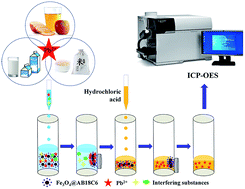4′-Aminobenzo-18-crown-6 functionalized magnetic nanoparticles as a solid-phase extraction adsorbent for the determination of Pb2+†
Abstract
A novel magnetic adsorbent has been designed and fabricated for the adsorption and determination of lead metal ions (Pb2+) based on a self-assembly approach between 4′-aminobenzo-18-crown-6 (AB18C6) and Fe3O4–CHO via dehydration condensation. 4′-Aminobenzo-18-crown-6 modified Fe3O4 (Fe3O4@AB18C6) was characterized by transmission electron microscopy (TEM), dynamic light scattering (DLS), Fourier transform infrared spectrometry (FT-IR), X-ray diffraction (XRD), vibrating sample magnetometry (VSM) and zeta potential analysis. Experiments proved that Fe3O4@AB18C6 had excellent adsorbability and selectivity for Pb2+, which is because the cavity of AB18C6 matches with the size of Pb2+. The magnetic solid-phase extraction (MSPE) method was applied for Pb2+ determination from tap water, rice, milk and apples. Furthermore, it was shown that the method had satisfactory linearity with a linear coefficient (R2) above 0.997, a linear range from 0.01 μg g−1 to 10 μg g−1, good precision with an RSD less than 8.62%, desirable recoveries ranging from 93.8% to 108.6%, and a low limit of detection (LOD) of 12.5 ng g−1 for Pb2+. The established MSPE method has excellent potential for the selective determination of trace Pb2+ from complicated samples.

- This article is part of the themed collection: Analytical Methods Recent HOT articles


 Please wait while we load your content...
Please wait while we load your content...